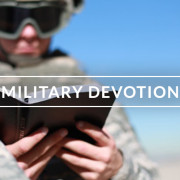Breath of life – September 22, 2019
Then the LORD God formed a man from the dust of the ground and breathed into his nostrils the breath of life, and the man became a living being.
Genesis 2:7
Devotion based on Genesis 2:7
See series: Military Devotions
It is called the human spirit. But the same Old Testament word is also translated as soul. The first time it is used in Scripture it is called, the breath of life.
It’s different from our body. It has been said, “The soul is the bearer of all that is life in man.” It is more than the ability to produce abstract thought, but that is part of it.
It was added to Adam’s lifeless body. God breathed this into him. When it leaves, the body is dead. But it is not. The soul, the breath of life, will never die.
But it can be lost.
A lost soul is one that has been separated from its Creator. The Bible calls that spiritual death. If its body dies while in this condition, body and soul will be separated from its God forever. That is the essence of hell, the place prepared for the devil and his angels.
Thus, there are two types of death: separation of the soul from the body; and separation of both the soul and body from God.
There are two types of life: the union of the soul with the body; and the one where the soul and body are united with God.
Jesus has this warning: “Do not be afraid of those who kill the body but cannot kill the soul. Rather, be afraid of the One who can destroy both soul and body in hell” (Matthew 10:28).
Those who put on a uniform to defend a country must realize that they may be killed as a result. History records that WWII claimed 27,600 lives every day. The tombstones litter the battlegrounds where they fell. Others were carried back home in caskets by the trainload.
The breath of life is no longer in them. The soul has separated from the body. We count them among the dead. We lower flags in their memory. We call their deaths tragic.
But then we ask, where are the people who survived that war? How many still breathe the air? And twenty years from now, how many then? Would the answer not be, “None”?
That could depress us—unless we remember that many of these actually still live. And we can live with them!
There is something called fatalism. It is the belief that everything is predetermined in life, and since everything dies or decays, the future is bleak.
But that was not the Creator’s plan for humans, and it is not the way it must be. He breathed life into Adam’s body so that Adam and his descendants might share with him the wonders of his glory.
That plan still stands. That life is still possible. Though forfeited, it has been reoffered as a gift.
Jesus came to earth to declare, “I have come that they may have life, and have it to the full” (John 10:10). To do that, he needed to give up his own life. And he did.
He finished his mission on earth with the words, “Father, into your hands I commit my spirit.” We are told, “When he had said this, he breathed his last” (Luke 23:46).
So what if someday our soul will leave its body? What difference does it make if our bones someday rest under a tombstone?
We stand with Job who announced that he knew that his Redeemer lives, and therefore, “After my skin has been destroyed, yet in my flesh I will see God…” (Job 19:26)
We have been given the breath of life—for time and eternity.
Prayer: Holy God, you have made us different from everything else on earth. You gave us the breath of life. You created a living soul. Preserve us, body and soul, as we continue our walk through life. When this earthly life is over, “take us to heaven to be with you there.” Amen.
Written and recorded by Rev. Paul Horn, WELS National Civilian Chaplain to the Military, San Diego, California.
All Scripture quotations, unless otherwise indicated, are taken from the Holy Bible, New International Version®, NIV®. Copyright ©1973, 1978, 1984, 2011 by Biblica, Inc.™ Used by permission of Zondervan. All rights reserved worldwide. Note: Scripture reading footnotes are clickable only in the web version.


